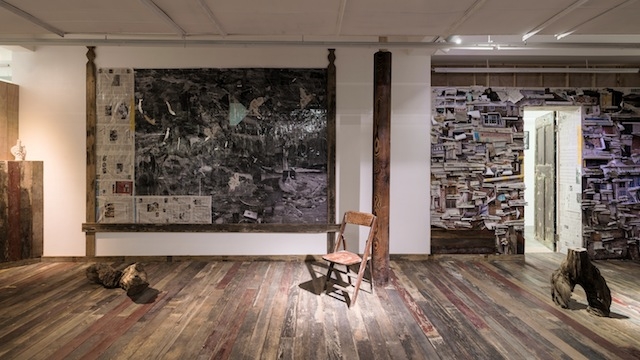The River Never Remembers Arario Gallery, Shanghai, 25 February – 31 March
The House Cannot Forget Bank, Shanghai, 25 February – 16 April
As one’s eyes adjust to the darkened space of Arario’s ground floor gallery, in which a collection of 12 mixed-media ink paintings are displayed on the walls, the compositions gradually reveal themselves to be representing sections of water. The dim environment makes it hard, at first, to distinguish immediate differences in the works of Chen Yujun’s monochrome series Mulan River No.1 (2013); the subject of the river, acting as a guiding current, gives the impression of a series that flows seamlessly. Yet on closer inspection, the divergences in their textural quality emerge from the gloom: some depict calm, eddying waters, while other works capture the coursing river, its tumbling turbulence creating a maelstrom of what looks like debris and driftwood. Stylistically, the series recalls the traditional shan shui aesthetic, though the elementally balanced world of Chinese landscape painting is disrupted here in an interpretation that plunges the viewer into threatening waters, resulting in a collection that is both culturally unheimlich and strangely mesmerising.
In these works, nature is an ongoing force, and man a mote in the lifetime of a river.
On the uppermost floor, a new site-specific installation titled Origin of Food (2017) features an assemblage of objects inside a three-dimensional oblong panel, on the back of which is a black-and-gold painting of an uprooted tree. The objects, including variously sized stones, carved wood and crockery, are carefully arranged in the manner of food offerings one might find at a shrine. The gold that clings to the branches and leaves of the tree gradually fades towards the base of the trunk. And although superficially dazzling, the exposed roots, which have been left plain black, as well as the seeming value bestowed upon simple lumps of rock, allude to a curious regression towards a more primitive ‘origin’. The sense of a lost civilisation is emphasised in Rite (2014), an ink drawing of a rickety pavilion formed of four stunted tree trunks, and in Wooden House No. 20130608 (2013), a huge painting of a tree supporting what looks like an unstable shacklike structure while creatures sit casually on the lower branches, undisturbed in the absence of humans. In these works, nature is an ongoing force, and man a mote in the lifetime of a river.
To enter the second part of the exhibition, The House Cannot Forget, at Bank, one has to pass under a simple paifang of two plain wooden pillars set atop brick bases. Before they became purely ornamental, such archways were traditionally used to divide different administrative districts in cities, marking the passage between and welcoming visitors into designated zones. Here, the visitor, by walking across the threshold of the arch from his Temporary Constructions series (2013–) becomes complicit in marking out the space as one that is inhabited, but also one that has defined social customs. The room appears to be some kind of reconstruction, laid with recycled wooden floorboards (of different colours, paint chipped and faded) and one corner wallpapered with newspaper cuttings from those local to Putian (Chen’s hometown), each piece curling up from the bottom. A chair, an empty chest and a painting of a single shoe hung on another wall indicate that this is a domestic space, but an abandoned one. A longan tree trunk squats conspicuously on the floor, which along with the series’ title reminds us that the materials with which we make our homes are borrowed from the land.
The cumulative nature of these human traces magnify the feeling of having just wandered through someone’s house, attempting to find in the things left behind some sense of their personalities.
The exhibition opened three days before Lunar New Year and continues through the spring season. This makes it easy to read the coming together and subsequent geographic dispersal of family members during the festival into Chen’s work. The obligatory annual family portrait of Four Seasons No. 1221 (2013) and the mountain of shoes left by the front door of the family home, portrayed here as a painting of jumbled footwear in Ours No.3 (2016), signal the gathering of people, just as Banquet No.1 (2016) reminds one of the carnage left at the end of a huge family meal – fish heads, bits of skin and bone strewn across the table ready to be wrapped up in a plastic bag-cum-table-cloth. The numerous iterations of collage-paintings of windows, also part of Temporary Constructions, gathered here might allude to each family member’s individuality, each window frame a different style, each view unique, and together they may form the windows of one household.
The cumulative nature of these human traces magnify the feeling of having just wandered through someone’s house, attempting to find in the things left behind some sense of their personalities. But using family dynamics to read the exhibition renders Chen’s work somewhat one-dimensional. Far more poignant are the wider relationships reflected here: the various ways in which we try to confine and manipulate nature, whether we shape it into houses or shan shui paintings, make sense of it through spirituality or attempt to align ourselves with specific familial (and by extension social) constructs.
Ultimately, these ideas come together in a recent sculpture from Temporary Constructions – this time a dilapidated houselike structure hoisted into the air by a thick rope tethered to a large piece of driftwood (recalling those buffeted in Mulan River No. 1). This sudden macro-perspective of the family home, dangling precariously, exposes the fragility and temporariness of the worlds we attempt to build around ourselves. The driftwood, bearing the weight of the house, reminds us of our inevitable return to the earth and offers comfort from a rather wider perspective. Regardless of how we attempt to frame or shape it, nature will run its course.
From the Summer 2017 issue of ArtReview Asia
